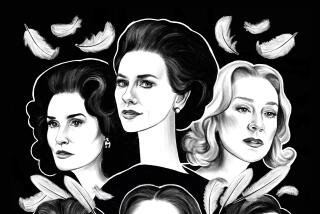Off-Centerpiece : Blame It on Bizet : The linking of sex and the danger of cigarettes has been around since ‘Carmen.’ Now smoking finds new meaning as a badge of humanity
- Share via
It hasn’t been this easy to get a light in years. In March at the Grammys, U2’s Bono sauntered onstage with a slim brown cigarillo seesawing up and down in the corner of his mouth. Before, during and after her notorious “Letterman” appearance, Madonna sucked away on a big fat stogie. In “Reality Bites,” Winona Ryder and Ethan Hawke subsisted on a steady diet of tobacco supplemented only by the occasional Big Gulp.
In this summer’s “The Client,” Susan Sarandon shares a tender moment and a cigarette with an 11-year-old boy. And just try to find a party-page picture of model Kate Moss where she’s not hiding behind a cigarette only slightly narrower than she is.
If you want to read more about it, stop into any bookstore and pick up a copy of Christopher Buckley’s satire of the tobacco industry, “Thank You for Smoking,” or Richard Klein’s eloquent analysis of the literary, philosophical and cultural history of smoking, “Cigarettes Are Sublime.”
At a time when Congress and anti-smoking groups are uniting to try to banish them from the American scene, cigarettes seem more a part of our culture than ever. And in the last two years--since Bill Clinton entered the White House, since the term Generation X became shorthand for “What’s wrong with you kids today?,” since the waif became a fashion trend instead of a charity case--the act of smoking has taken on a whole new significance.
Cigarettes haven’t changed; we have, and as a result, we’re sending a different message by smoking them.
It’s not that we don’t know tobacco is bad for us. Every man, woman and child in America--except, of course, the CEOs of the major cigarette manufacturers--knows that. But these days the fact that cigarettes can kill you only seems to increase their appeal.
Wielded with an aggressive fatalism by high-profile puffers from Denis Leary and Jack Nicholson to just about everyone the media has knighted “Young Hollywood,” cigarettes send thick and lingering messages: part challenge, part existentialist credo (what better way to say carpe diem , dammit?), part symptom.
The allure--the sex mixed with the death and danger of cigarettes--has wafted through entertainment since Bizet’s “Carmen,” about a tragic love affair between a soldier and his cigarette-rolling girlfriend, became a hit in 1875. The cigarette-factory girls in “Carmen” made an early connection between smoking and sex: “The sweet talk of lovers--that is smoke. Their transports and their vows--all that is smoke.” And it took off from there.
For one thing, cigarettes placed strategically, in the right hands, look really good and give focus to a scene.
“I love it as a prop,” says photographer Helmut Newton. “I think it’s very sexy, and it gives the person something to do. When you look at movies between the wars, people never stopped smoking or drinking.”
Just look at “Casablanca,” a film in which the bewitching haze of smoke never clears.
“Take Bogart,” says MTV talk-show host and smoker Jon Stewart. “Not an attractive guy. So what was it that drew the Ingrid Bermans and the Lauren Bacalls? Obviously it was accessorizing with a cigarette. Without the cigarette, he’s Peter Lorre.”
*
For years, the cigarettes-as-sex metaphor was the main message Hollywood was sending when it smoked. It started out simply and, like sex, has gotten increasingly more complicated, evolving from movies like “To Have and Have Not” and “Now, Voyager”--in which showing two people smoking was as close as a director could get to showing them having sex--to ‘80s erotic thrillers like “Fatal Attraction” and “Basic Instinct,” in which smoking was tantamount to S&M.;
In more recent AIDS-aware movies like “Reality Bites,” there is a tacit if grim acknowledgment that both sex and smoking are deadly, but, hey something’s gonna kill you--probably sooner rather than later--and there aren’t any good jobs out there anyway, so. . . .
But sex isn’t the only signal being sent by cigarettes in the movies. By the middle of the health-obsessed, family-valuing, moralistic but hypocritical ‘80s, smoking began to be recast as the purview of the villain, the neurotic, the unstable, the corrupt. Bad cops (Richard Gere in “Internal Affairs”), bad moms (Anjelica Huston in “The Grifters”) and coldhearted white-collar guys (Harrison Ford in “Regarding Henry”) smoked, and generally they got their comeuppance for it.
“Cigarettes were a flash card,” says “Thank You for Smoking” author Buckley. “It was axiomatic: If a guy lit up, he wasn’t in control of his own destiny.”
More recently, smoking has shifted from being almost sociopathic behavior to taking on an edge of world-weary resignation, particularly in those films that lay claim to an understanding of Generation X’s pain.
“It’s a device used to show recklessness,” says Janeane Garofalo, who starred as Winona Ryder’s pot-smoking, sex-without-strings, Gap-managing best friend in “Reality Bites.” The smoker has become “a rebel, a gutsier person,” she says. “And there’s something liberating about not caring about the consequences.”
In her West Hollywood neighborhood, Garofalo says, smokers feel so hunted that a sort of speak-easy mentality has emerged: “I think you’re seeing a lot more young people smoking in coffeehouses. In places that look the other way, business is definitely improving.”
Unrepentant smokers are rare among the politically correct, not to mention sponsor-conscious, world of television. (“We’re discouraged by the network from showing main characters smoking,” says “NYPD Blue” co-creator David Milch.)
But recently the tube has shown compassion for the tobacco-addicted on shows like “NYPD Blue” and miniseries like “Prime Suspect,” on which smoking characters have struggled to quit. “Sipowicz was a smoker in the first two episodes,” Milch says of the “NYPD Blues” character. “But when he got shot, he gave it up.” Apparently getting shot works better than hypnotism.
And “Prime Suspect,” the British miniseries that aired on PBS, has made Chief Inspector Jane Tennyson’s smoking part of the evolving story line. In the first installment she smoked, in the second she quit, and in the third she struggled to stay on the wagon; simply knowing that she wanted to smoke somehow helped us understand her troubled nature better.
At least one new film takes smoking as human foible even further. In next month’s “The Client” (from the book by John Grisham), Susan Sarandon plays a lawyer with a past who finally reaches a distant young boy--by sharing her cigarette with him.
“It came out of character,” says “Client” director Joel Schumacher. “She touches him so profoundly that when he reaches forward, if they were adults, he would kiss her. I’m sure we’ll get a lot of criticism for that. I’m sure effigies of Susan will be burned.” Sarandon, perhaps fearing the same thing, refused to approve any still photography that showed her smoking.
*
So it’s no longer just the villains who inhale; now it’s real people with real flaws and real weaknesses who smoke. Now smoking is being used to show vulnerability; it’s a badge of humanity.
In the current “When a Man Loves a Woman,” in which Meg Ryan portrays a recovering alcoholic wife and mother, the viewer is actually relieved to see her chain-smoking, because it means she hasn’t taken another drink.
And in “The Client,” at least a couple of the bad guys smoke only because the actors playing them, Anthony LaPaglia and Kim Coates, are heavy smokers themselves. “They’re almost desperate without cigarettes,” says Schumacher, who doesn’t allow smoking on his sets unless it’s part of a scene. “It’s almost easier just to let them smoke.”
Schumacher’s concern for his actors is a good example of the way smoking has again become OK in film and television: We don’t care as much about healthy people (particularly if they’re playing villains). But give us men or women so troubled that they don’t care whether they live or die--so much in pain that they need the immediate comfort of a cigarette--and for them, we can have compassion. One screenwriter who knows says: “Women love unhappy men. They find them sexy.”
So maybe it’s not the cigarettes themselves that make Bono or Bogart and Ethan Hawke appealing but what they represent--a troubled person living in a troubled world, who, from a certain angle, when the smoke gets in his eyes, may look a little bit like you.*
More to Read
The biggest entertainment stories
Get our big stories about Hollywood, film, television, music, arts, culture and more right in your inbox as soon as they publish.
You may occasionally receive promotional content from the Los Angeles Times.










